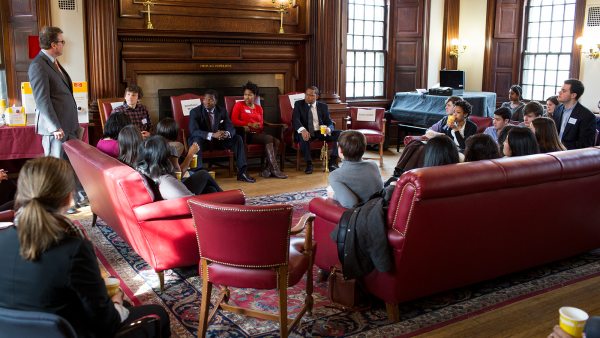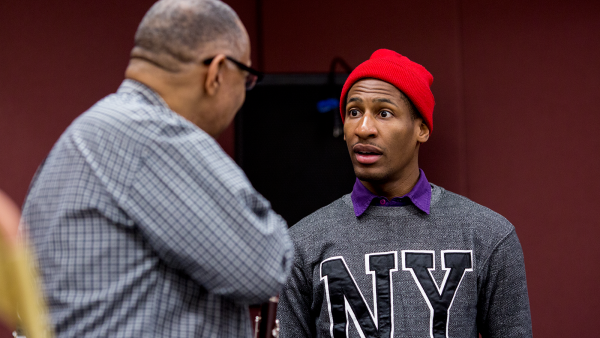Wynton Marsalis on the Soul of Jazz
In the city of New Orleans, after the Civil War and into the first decade of the twentieth century, brass bands could be heard playing at baseball games, churches, political rallies—and even in homes, to call children to dinner.
But when it came to jazz, musician Wynton Marsalis said at Sanders Theatre on January 30, Charles J. “Buddy” Bolden was the musician whose distinctive sound—embodying a mixture of cultures and passions—helped define New Orleans as a city of music.
Weaving history with anecdote—and, of course, his own music—M arsalis used “New Orleans: The Birth of Jazz,” the sixth and final lecture of his multiyear performance and lecture series at the University, to tell Bolden’s story. (The lectures, “Hidden in Plain View: Meanings in American Music,” began in the spring of 2011.) Marsalis’s lecture-performance used the racial, cultural, and musical elements of New Orleans jazz from 1885 to 1910 as a way to examine the relationship between American music and American identity.
President Drew Faust introduced Marsalis, saying she knew “at the outset” about the “Wynton Marsalis magic—his virtuosity, his originality, his charismatic intelligence,” but could not have anticipated how generous he would be during his time at Harvard: working with students, speaking around campus, and researching and writing the lectures. “[It’s] not just writing,” Faust said, “but crafting each lecture into an irresistible synthesis of performance and analysis on nothing less than American identity.”
“Great players all come from Bolden, and all reflect him in some way,” Marsalis said. “He had a band of seven pieces and his band competed with other bands for the affection of fans. We know he lost his mind—he was committed to an insane asylum where he lived out his life and died. And now, I read his legend and I wonder ‘How many brilliant artists go crazy?’”
Reviving Bolden’s actual scores, Marsalis’s nine-man orchestra—t rombones, horns, a piano, string instruments, and Marsalis himself on trumpet—used musical notes to paint a picture of Marsalis’s native New Orleans through its most transformative century, evoking images of street peddlers singing about the watermelons they had for sale, church choirs lending melody to prayer, and bands playing on the street and battling each other in city parks, where audiences of blacks, whites, Hispanics, Creoles, and Italian and French immigrants would gather by the thousands to soak in the spirit of the music.
Marsalis traced the history of the Crescent City through the cultures and backgrounds of its varied inhabitants, illustrating how cultural cross-pollination led to an exuberantly diverse music scene. He discussed what he felt was a turning point for music, when the Irish-born Patrick Gilmore came to New Orleans in 1864 with a 35-piece band from Boston. “Gilmore’s Famous Band,”; Marsalis said, was hired to support Michael Hahn’s gubernatorial campaign, and they performed for two months throughout the city. When Hahn was elected, Gilmore organized a musical event that utilized more than 5,000 citizens and military personnel from both the U.S. and Confederate armies to create what Marsalis called “an integrated music social spectacle.”
“This event attracted 35,000 people,” he continued, “and fulfilled what Abraham Lincoln would call ‘an attempt to keep the jewel of liberty within the family of freedom.’” “The Gilmore experience inspired excellence and brought about a level of intensity and cultural engagement that would remain in the community for a generation.”
When America purchased the Louisiana territory in 1803, Marsalis said, it had no idea what a prize it had acquired in New Orleans—”a gumbo of sensitivities.” Marsalis said the compact and diverse musical culture in his hometown was analogous to “going from a rap group to the New York Philharmonic two blocks away.”
The “downtown” musicians, like Bolden’s rival Jack Robichaux, trained in the classical European conservatory style, while many uptown musicians, like Bolden, could not read and played mainly by memory and ear. “When you can’t read, you have more bandwidth for expression,” Marsalis said. “Absolutely none of your time is spent trying to decipher symbols. Music was the only symbol.”
After he described jazz as the heart of “the Negro soul,” the band at his cue broke into a traditional slave song that gripped the audience with emotion that was palpable throughout the hall. Throughout the evening, the ensemble swung into the music of whatever subject Marsalis covered, from blues and waltzes to ragtime.
New Orleans between 1885 and 1910 was a place like no other, Marsalis said, adding that jazz was born there amid a diversity of people, philosophies, and possibilities, and has proven the most definitive artistic symbol of American democracy. “To gain… a[n] important understanding of our collective past, it’s important to search for the echo of that past in our own experiences,” he concluded. “There, we find the common symbols that allow us to grasp the fundamental meaning of the aspirations we share with our ancestors.”
Source: Harvard Magazine




